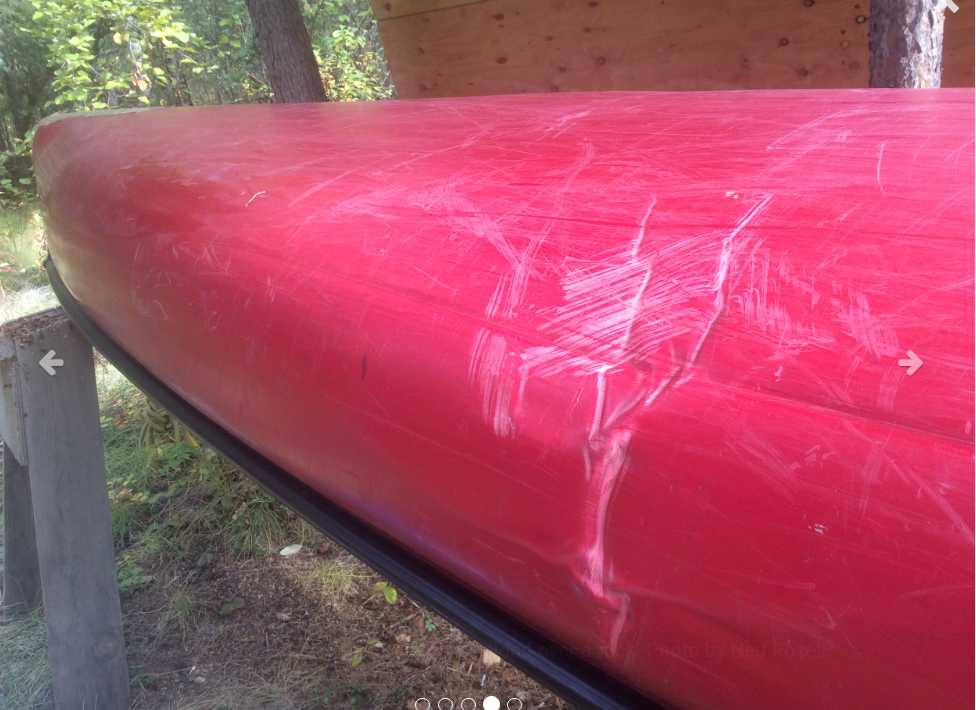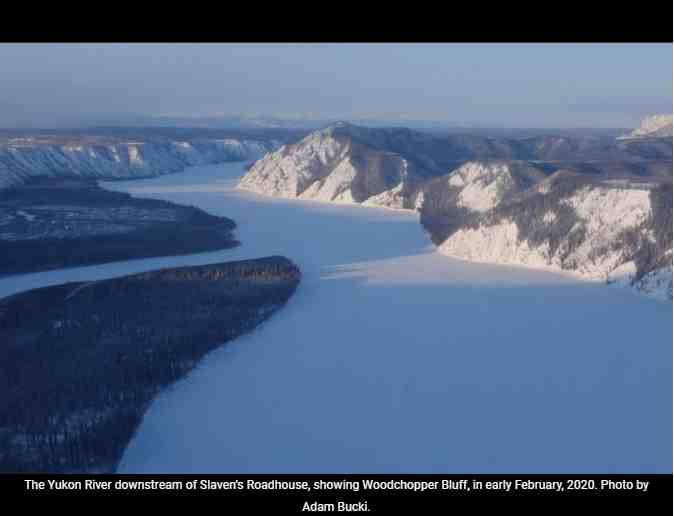
It’s midsummer, a good time to slip a canoe onto the Yukon River.
I start at the river town of Eagle, population 85, and will finish in Circle, population 104. Circle is about 170 twisting miles downriver.
The Yukon is the longest and highest-volume river by far in Alaska. It is the third-longest in the U.S., after the Mississippi and the Missouri. At Eagle, the Yukon quietly piles into Eagle Bluff and turns northward. It is smooth, dimpled with gentle whirlpools and more than one-quarter mile wide.
Eagle, Alaska, is a few hundred miles into the Yukon’s 2,000-mile run from its origin in high places of northwest Canada to the Bering Sea.
The Yukon at Eagle in mid-summer carries about 180,000 cubic feet of water each second past Belle Island in front of town. This is down from the Yukon’s peak flow in mid-June, when the big river was receiving the last of winter’s snowmelt and a good pulse of meltwater from glaciers. Its low period, with one-thirteenth of the moving water it has now, is in early April.
Looking at that broad river, the color of coffee with a good dose of cream, it’s easy to believe that one-third of Alaska’s moving freshwater makes it into the Yukon. It’s as if Texas and Oklahoma were tilted so all their water ran the same way.
For all its huge flow and power, the Yukon for most of its length is flat as a sheet of plywood, rated Class 1 (easy) on the international scale of boating difficulty. The biggest hazard seems to be winds that sometimes run unchecked because the river is a mile wide in places.
The breeze is gentle as I shove our 16.5-foot red canoe into the water near Eagle Bluff. My dog Cora perches on the seat in the bow. Slipping into the 5-mile-per hour current, we hear a hiss that sounds like a breeze through aspen leaves.
That sound is powdered mountain hitting the skin of the canoe, part of the 60 million tons of silt, sand and clay the river carries to the Bering Sea each year, according to a USGS report authored by Tim Brabets and others in 2000. Most of this suspended earth near Eagle is from the White River, which carries runoff from the Wrangell Mountains into Canada and sullies what was a lovely turquoise waterway.[xyz-ihs snippet=”Adversal-468×60″]
A few bends downriver from Eagle, we cross over to a camp on the river with fish nets hanging on wooden racks out front. We arrive at the same time as two men in a motorboat: A technician from the Alaska Department of Fish and Game and one from Oceans and Fisheries Canada. They are counting king and chum salmon using nets strung across river eddies. Others at the camp are monitoring sound waves broadcast and received across this channel of the river with no islands between its banks.
Inside a plastic and metal weatherport up the riverbank, Barry Westphal of Eagle points to a squiggle on a computer screen. It is a sonar representation of a king salmon swimming upstream. Westphal, working for the Alaska Department of Fish and Game, and others are counting king salmon and the later-migrating chum salmon to be sure enough make it back to spawning sites upstream in Alaska and Canada. The Canada border, visible as a straight swath cut through the boreal forest, is about 18 miles upstream from the sonar station.
Cora and I camp the first night at the mouth of Tatonduk River, a clear-running stream that reaches deep into limestone peaks in Canada. There on a gravel/mud bar, we have a dinnertime view of a smoking mountain. The Windfall Mountain fire has been burning since at least fall 2012, when Eagle residents heard an explosion and noticed smoke rising from the area. The mountain might have a base of flammable oil shale, but it’s a hard place for scientists to explore; the smoking heap of orange rocks remains a mystery.[xyz-ihs snippet=”Adsense-responsive”]Most of our float from Eagle to Circle is within the boundaries of Yukon-Charley Rivers National Preserve, which is shaped like West Virginia and one-sixth the size. The preserve, a quieter place today than it was during the Gold Rush, creates a buffer zone around the entire watershed of the clear-running Charley River.
We stop for a night at the Nation Bluff cabin, one of several that preserve workers have restored as public-use cabins. Finding the door of the 1930s-era structure tight enough to exclude mosquitoes, Cora and I spend the night. In the jungle of grass just outside the window, white-crowned sparrows tend to a nestful of hatchlings. In a month, those helpless chicks will lift over the glassy Yukon and start winging their way toward the Baja Peninsula in Mexico.
The next morning, while twirling through an eddy near a mid-river island, we see movement on the shore and there is, suddenly, a gray-black wolf. The muscular canine is twice Cora’s size. The wolf sees us, scrambles up the bank of the island, and disappears. A 20-foot driftwood log falls to the river after the wolf leaps from it.
The preserve is home to a dozen packs of wolves; this one may be part of the Edwards pack. One of the individuals from the same pack, satellite collared by biologist John Burch, wandered more than 2,000 miles during summer and fall of 2011. Burch found the lone male near the Kanuti River after it starved to death, a common ending for wolves. Its collar showed the wolf approached only one road in its journey. It paused on the eastern side of the Dalton Highway many times, but it never crossed.
A few hours after the rare treat of seeing the wolf, I see three canoes on the far bank of the river. I cross over and beach my canoe. Randy Brown is standing there to greet me. He is a fisheries biologist for the U.S. Fish and Wildlife Service who lived in this quiet country for many years. He now lives in Fairbanks, and is camping here with his wife Karen Kallen-Brown and a few of their friends.
Brown recently authored a paper in which he traced the known birthing streams of all the king salmon born in the Yukon watershed. A surprise result: two of the most productive spawining streams in the entire drainage were the Salcha and Chena rivers near Fairbanks.
Brown is not working out here on the Yukon River island. He and his wife are suspending a gill net with a series of oval floats from the base of a landslide bluff across the river. As they last did in the 1990s, they are fishing for king salmon. The Brown family lived on the Kandik River and came out to the Yukon for fish camp every July back then. This year, they will catch seven kings before motoring back upriver to Eagle, packing up, then making the 10-hour drive to Fairbanks.
I drift on, smelling clean, wet sagebrush on cliffs soaked by a rainshower. Like other south-facing hillsides in Alaska, many along this stretch of the Yukon are what scientists call steppe bluffs. These treeless, lime green hillsides are home to plants that lived in Alaska during the last ice age.
Cora and I continue on to Coal Creek, where stands the striking two-story log structure known as Slaven’s Roadhouse. Miner and roadhouse operator Frank Slaven built it with help from his friends in the late 1930s. National Park Service workers restored it in 1993 and 1994.
At the river landing are a canoe belonging to a German couple floating the entire river, a riverboat owned by a family from Circle and a Piper Super Cub on floats. Ecologist and pilot Amy Larsen, who works for the National Park Service, landed the plane on the Yukon into the current and taxied it over to the landing. She is working a few weeks here to continue her studies of shallow lakes in Yukon-Charley and other parks. Many of those thousands of water bodies are shrinking or changing in other ways as air temperatures warm.
On the last full day of the trip, we drift past the dagger-like Tacoma Bluffs, created as water percolated for thousands of years through limestone and dolomite. Downriver from there and heading toward Circle, the landscape pancakes out to Yukon Flats. Savoring the view of the white towers, I notice a boat parked on the far side of the river.
I paddle over to the boat and find the person I’ve been searching for since Randy Brown told me he was on the river. Biologist Skip Ambrose and his wife, biologist Chris Florian, invite me to share their dinner, which Chris has cooked in a Dutch oven. I’m happy to, and while I’m there I listen to one of the great success stories in wildlife conservation.
For the past 46 years, Ambrose has monitored peregrine falcons on the bluffs from Circle upriver to Canada. That research will be the subject of next week’s column.
Source: Geophysical Institute








